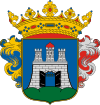Stuhlweissenburg
| Székesfehérvár | ||||||||
|---|---|---|---|---|---|---|---|---|
| City | ||||||||
From the top, left to right: Hungarian Royal Hotel, Cathedral of Székesfehérvár, Aunt Kati statue, Árpád Spa, Episcopal Palace, and Csók István Gallery & Vörösmarty Mihály Library
|
||||||||
|
||||||||
| Nickname(s): Fehérvár, Hungarian Crowning City, City of Kings, City of Churches | ||||||||
| Location of Székesfehérvár | ||||||||
| Coordinates: 47°11′20″N 18°24′50″E / 47.18877°N 18.41384°E | ||||||||
| Country | Hungary | |||||||
| County | Fejér | |||||||
| Government | ||||||||
| • Mayor | András Cser-Palkovics (Fidesz-KDNP) | |||||||
| Area | ||||||||
| • Total | 170.89 km2 (65.98 sq mi) | |||||||
| Elevation | 118 m (387 ft) | |||||||
| Population (2014) | ||||||||
| • Total | 99,060 |
|||||||
| • Rank | 9th | |||||||
| • Density | 579.67/km2 (1,501.3/sq mi) | |||||||
| • Demonym | székesfehérvári, fehérvári | |||||||
| Population by ethnicity | ||||||||
| • Hungarians | 95.7% | |||||||
| • Gypsies | 0.5% | |||||||
| • Germans | 0.8% | |||||||
| • Slovaks | 0.04% | |||||||
| • Others | 2.96% | |||||||
| Population by Religion | ||||||||
| • Roman Catholics | 53.8% | |||||||
| • Atheists | 19.7% | |||||||
| • Calvinists | 12.1% | |||||||
| • Lutherans | 1.9% | |||||||
| • Greek Catholics | 0.5% | |||||||
| • Others | 12% | |||||||
| Time zone | CET (UTC+1) | |||||||
| • Summer (DST) | CEST (UTC+2) | |||||||
| Postal code | 8000 | |||||||
| Area code(s) | 22 | |||||||
| Website | www |
|||||||
The city of Székesfehérvár (Hungarian pronunciation: [ˈseːkɛʃfɛheːrvaːr]; see also other alternative names), located in central Hungary, is one of the largest cities in the country. Székesfehérvár was the capital of Hungary in the Middle Ages. Now the city is regional capital of Central Transdanubia, the centre of Fejér county and Székesfehérvár District. It was one of the most important cities of Hungary. In the Székesfehérvár Basilica (one of the largest basilicas in medieval-Europe), where the Diets were held and the crown jewels kept, thirty-seven kings and thirty-nine queens consort were crowned and fifteen rulers buried. .
The name Székesfehérvár means "white castle of the (royal) seat" and the city is known by translations of this in other languages (Latin: Alba Regia, German: Stuhlweißenburg, Slovak: Stoličný Belehrad, Serbian: Столни Београд, Stolni Beograd, Croatian: Stolni Biograd, Slovene: Stolni Belograd, Czech: Stoličný Bělehrad, Polish: Białogród Stołeczny or Białogród Królewski, Turkish: İstolni Belgrad). In Hungarian, the city is known colloquially as Fehérvár.
...
Wikipedia








